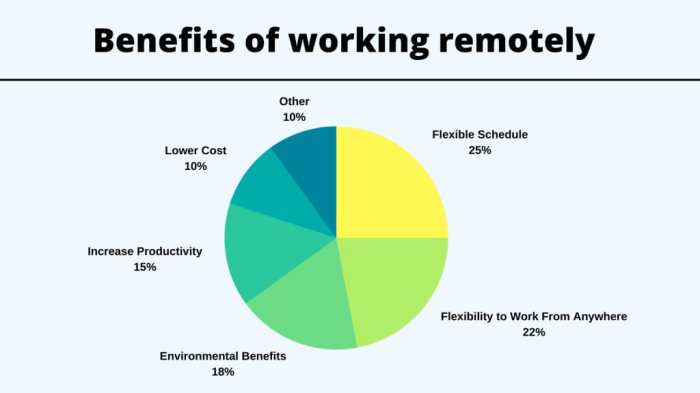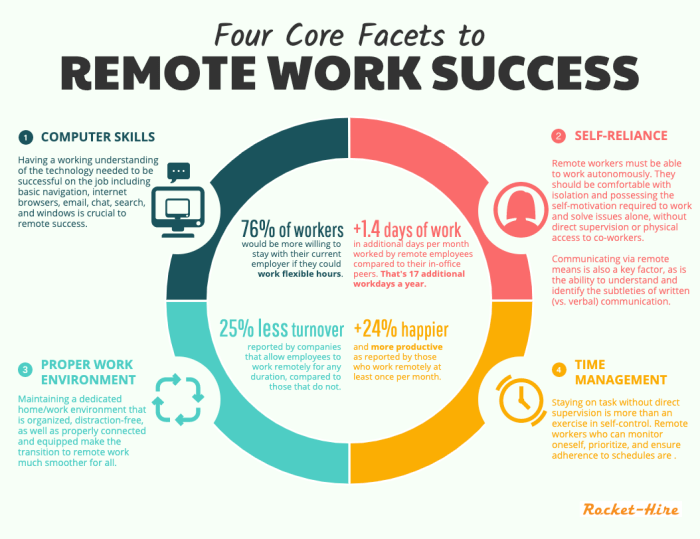Remote Work Productivity is not just about getting tasks done, it’s about creating a balance between efficiency and mental well-being in a virtual work environment. As we dive into the realm of remote work productivity, let’s explore the key factors, strategies, tools, and psychological aspects that play a crucial role in maximizing productivity and maintaining a healthy work-life balance.
Factors Affecting Remote Work Productivity
Working remotely comes with its unique set of challenges that can impact productivity. Factors such as communication, work environment, and technology play a crucial role in determining how efficient one can be while working from home.
Communication
Effective communication is key to successful remote work. Without face-to-face interactions, clear and concise communication through emails, video calls, and messaging platforms is essential. Misunderstandings can easily arise when communication is lacking, leading to delays in projects and decreased productivity.
Work Environment
The work environment at home can greatly influence productivity. Distractions such as noise, family members, or household chores can disrupt focus and hinder work progress. Creating a dedicated workspace that is free from distractions can help maintain productivity levels and mimic the structure of a traditional office setting.
Technology
Reliable technology is crucial for remote work productivity. Issues with internet connectivity, software, or hardware can lead to delays and frustration. Ensuring that employees have access to the necessary tools and resources to effectively carry out their tasks is essential for maintaining productivity levels.
Comparison with Traditional Office Settings
Remote work poses unique challenges compared to traditional office settings. While remote work offers flexibility and eliminates commute time, it can also lead to feelings of isolation and difficulty in separating work from personal life. In traditional office settings, face-to-face interactions may foster better collaboration and communication among team members, but can also result in distractions and interruptions.
Strategies for Enhancing Remote Work Productivity
In today’s fast-paced work environment, remote work has become increasingly common. To ensure optimal productivity while working remotely, it is essential to implement effective strategies that help you stay focused and organized.
Time Management
Effective time management is crucial for remote work productivity. Create a daily schedule outlining tasks and deadlines, prioritize your work, and use tools like calendars and task managers to stay on track. Set aside specific time blocks for focused work and breaks to maintain productivity throughout the day.
Setting Boundaries
Establish clear boundaries between work and personal life to avoid burnout and maintain productivity. Define specific work hours and communicate them to your team or clients. Create a designated workspace that is free from distractions and signals to your brain that it’s time to work.
Avoiding Distractions
Identify potential distractions in your work environment and take steps to minimize them. Turn off notifications on your phone, limit social media usage during work hours, and communicate with family members or housemates about your need for uninterrupted work time. Utilize noise-canceling headphones or background music to create a focused work environment.
Dedicated Workspace, Remote Work Productivity
Create a dedicated workspace that is separate from your living area to enhance focus and productivity. Choose a quiet and well-lit area with ergonomic furniture to support good posture. Personalize your workspace with plants, artwork, or other items that inspire creativity and motivation.
Work-Life Balance
Maintaining a healthy work-life balance is essential for remote work productivity. Set boundaries between work and personal time, take regular breaks throughout the day, and prioritize self-care activities like exercise, meditation, or hobbies. Remember to disconnect from work at the end of the day to recharge and prevent burnout.
Tools and Technologies for Remote Work Productivity

In today’s remote work landscape, having the right tools and technologies can make a significant difference in productivity levels. By leveraging software solutions tailored for project management, communication, and collaboration, remote teams can streamline their workflows and optimize efficiency.
Project Management Software
- Project management tools like Trello, Asana, and Jira help remote teams stay organized by tracking tasks, deadlines, and progress in real time.
- These platforms enable team members to collaborate on projects seamlessly, assign tasks, and monitor project timelines effectively.
- Utilizing project management software ensures that everyone is on the same page, leading to improved productivity and project outcomes.
Communication Tools
- Communication tools such as Slack, Microsoft Teams, and Zoom facilitate instant messaging, video conferencing, and file sharing among remote team members.
- These platforms promote quick and efficient communication, reducing delays and misunderstandings that can hinder productivity.
- By fostering seamless communication, remote teams can collaborate more effectively and stay connected regardless of physical distance.
Automation Tools
- Automation tools like Zapier and Microsoft Power Automate help streamline repetitive tasks and workflows, saving time and boosting productivity.
- By automating routine processes, remote workers can focus on more value-added tasks, increasing overall efficiency and output.
- Integrating automation tools into daily workflows can lead to significant time savings and improved productivity levels for remote teams.
Virtual Meeting Platforms
- Virtual meeting platforms such as Zoom, Google Meet, and Skype provide remote teams with the ability to conduct face-to-face meetings and presentations from anywhere.
- These platforms offer features like screen sharing, recording capabilities, and virtual backgrounds, enhancing the overall meeting experience for remote participants.
- By leveraging virtual meeting platforms, remote teams can maintain a sense of connection and collaboration, leading to more productive and engaging meetings.
Psychological Well-being and Remote Work Productivity

The relationship between mental health, motivation, and productivity in remote work scenarios is crucial. When employees feel mentally well, they are more likely to stay motivated and maintain high levels of productivity while working remotely.
The Importance of Social Interaction
Social interaction plays a vital role in remote work productivity. It helps employees feel connected to their colleagues, reducing feelings of isolation and boosting morale. Regular virtual meetings, team-building activities, and casual conversations can enhance social interaction and overall well-being.
- Organize virtual coffee breaks or happy hours to encourage informal interactions among team members.
- Implement a buddy system where employees can connect with each other for support and collaboration.
- Use collaboration tools like Slack or Microsoft Teams to foster continuous communication and engagement.
Feedback and Recognition
Providing feedback and recognition is essential for maintaining high productivity levels in remote work settings. Employees thrive on acknowledgment for their hard work and achievements, which in turn boosts motivation and job satisfaction.
- Schedule regular performance evaluations to provide constructive feedback and recognize employees’ contributions.
- Utilize platforms like Trello or Asana to track individual and team progress, offering real-time feedback and praise.
- Implement a rewards system to incentivize and recognize outstanding performance, fostering a culture of appreciation and motivation.
Combatting Feelings of Isolation, Burnout, and Stress
Feelings of isolation, burnout, and stress can negatively impact employees’ mental well-being and overall productivity. It is essential to address these challenges proactively by implementing strategies to support employees’ mental health and work-life balance.
- Encourage regular breaks and time off to prevent burnout and recharge employees’ energy levels.
- Promote physical activity and mindfulness practices to reduce stress and improve mental clarity.
- Offer access to mental health resources and counseling services to support employees’ well-being and provide a safe space for addressing mental health concerns.